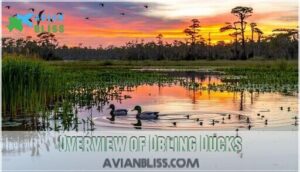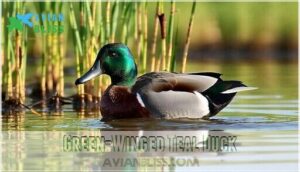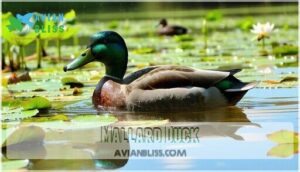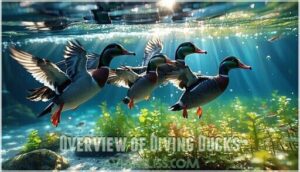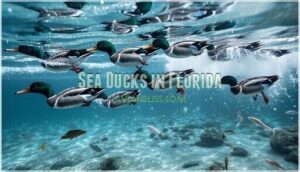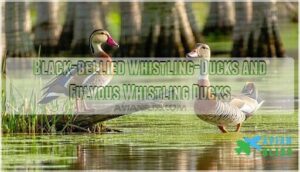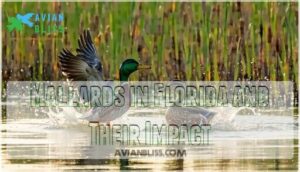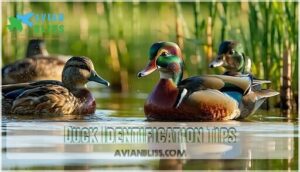This site is supported by our readers. We may earn a commission, at no cost to you, if you purchase through links.
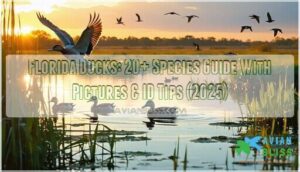
The state’s signature Mottled Duck thrives in coastal marshes, while Northern Pintails and other waterfowl escape harsh northern winters here.
Florida ducks range from dabbling species like Gadwall and Green-winged Teal that tip forward to feed, to diving ducks such as Ring-necked Ducks and Ruddy Ducks that plunge underwater for food.
Sea ducks like Hooded Mergansers frequent coastal waters, and you might spot the unusual Black-bellied Whistling-Duck perching in trees.
Each species has distinct field marks, from colorful wing patches to unique bill shapes that reveal their feeding habits and preferred habitats across the Sunshine State’s diverse wetlands.
Table Of Contents
- Key Takeaways
- Most Common Ducks in Florida
- Overview of Dbling Ducks
- Overview of Diving Ducks
- Sea Ducks in Florida
- Black-bellied Whistling-Ducks and Fulvous Whistling Ducks
- Mallards in Florida and Their Impact
- Waterfowl Hunting and Regulations
- Wood Ducks in Florida
- Duck Identification Tips
- Preservation and Management of Duck Populations
- Frequently Asked Questions (FAQs)
- What kind of ducks are there in Florida?
- Why are there so many Muscovy ducks in Florida?
- What ducks are native to Florida?
- How do ducks adapt to urban areas?
- Best time for duckwatching in Florida?
- What duck breeds are endangered in Florida?
- How do ducks contribute to wetland health?
- What ducks migrate through Florida during spring?
- When is peak duck watching season in Florida?
- Which Florida ducks are best for beginners to identify?
- Conclusion
Key Takeaways
- You’ll find over 20 duck species in Florida, ranging from year-round residents like Wood Ducks and Mottled Ducks to winter visitors like Northern Pintails and Ring-necked Ducks that escape harsh northern climates.
- Florida’s native Mottled Duck faces serious conservation threats from hybridization with non-native Mallards, prompting active management efforts including genetic monitoring and feral Mallard removal programs.
- You can identify Florida ducks by examining key features like beak shapes, distinctive white patches on wings or heads, and behavioral differences between dabbling ducks that tip forward and diving ducks that plunge underwater.
- Winter months from November through March offer the best duck-watching opportunities when 80% of migrant species arrive, making Florida’s wetlands prime viewing locations for spotting the greatest variety of waterfowl.
Most Common Ducks in Florida
You’ll spot several common ducks Florida offers year-round, including the stunning Wood Duck with its distinctive tree-perching behavior and the widespread Mallard thriving in urban parks despite habitat loss impacts.
The Mottled Duck represents Florida’s native waterfowl, facing conservation challenges from hybridization and climate change effects.
For duck identification enthusiasts, the subtle Gadwall and colorful Green-Winged Teal provide exciting spotting opportunities.
These Florida waterfowl species showcase remarkable adaptability to human interaction effects, maintaining stable duck population trends across diverse wetland habitats throughout the state.
The wetlands also host elegant Great Blue Herons known for their fishing skills.
Overview of Dbling Ducks
You’ll find dabbling ducks throughout Florida’s wetlands, where they feed by tipping forward and filtering food from shallow water with their heads submerged.
These surface-feeding ducks include some of Florida’s most recognizable species like Mallards and Wood Ducks, each adapted to specific habitats from quiet marshes to tree-lined swamps.
Gadwall
Gadwalls represent some of Florida’s most overlooked ducks despite their widespread presence.
You’ll find these dabbling ducks in shallow wetlands, easily recognizable by their Gadwall plumage—mottled brown-gray feathers with distinctive black rear patches.
Their Gadwall diet consists of aquatic vegetation and seeds.
Gadwall habitat includes marshes and calm waters throughout Florida.
Thanks to strong Gadwall conservation efforts, populations remain stable across North America’s wintering grounds.
Green-Winged Teal Duck
Measuring just 12.2 to 15.3 inches, Green-winged Teals are Florida’s smallest dabbling ducks.
You’ll spot these compact visitors during winter months, when Teal migration brings them south from northern breeding grounds.
- Teal size: Weighs only 4.9-17.6 ounces with 20.5-23.2 inch wingspan
- Teal habitat: Prefers shallow marshes, flooded rice fields, and muddy pond edges
- Teal diet: Feeds on seeds, aquatic plants, and small invertebrates by dabbling
Mallard Duck
You’ll recognize mallards by their iridescent green heads and yellow bills.
These adaptable Florida ducks frequent lakes, ponds, and marshes year-round.
Their omnivorous diet includes aquatic plants, seeds, and insects.
While stunning birds, mallard hybrids with native mottled ducks create conservation concerns for wildlife managers protecting Florida’s unique waterfowl populations.
| Feature | Description |
|---|---|
| Plumage | Males: green head, white collar, brown chest |
| Diet | Seeds, aquatic vegetation, invertebrates |
| Habitat | Shallow wetlands, city parks, golf courses |
| Behavior | Surface feeding, dabbling, highly social |
Mottled Duck
You’ll find Mottled Ducks year-round in Florida’s shallow wetlands, where their genetic diversity faces serious conservation challenges from mallard hybridization.
These medium-sized duck species Florida residents show subtle plumage variations and nocturnal breeding habits.
Their mottled duck diet includes aquatic plants and invertebrates.
Regional distribution centers on south Florida wetlands, making duck conservation Florida efforts essential for preserving this prairie ecosystem cornerstone in threatened duck habitats Florida.
Northern Pintail
Northern Pintail ducks showcase elegance with their streamlined silhouettes and distinctive pointed tails.
You’ll spot these graceful migratory birds in Florida during winter months in shallow wetlands and flooded fields.
Their Pintail Diet consists mainly of seeds and aquatic plants.
Key Pintail Identification features include:
- Long, slender neck – Creates their signature elegant profile
- Chocolate-brown head (males) with white breast stripe extending up the neck
- Pointed tail feathers – Give them their "pintail" name
These duck species favor open Pintail Habitat like marshes and agricultural areas during Pintail Migration.
Florida birdwatching enthusiasts often find them in large flocks.
Pintail Conservation efforts focus on protecting Florida wetlands critical for these stunning migratory birds.
Overview of Diving Ducks
Diving ducks swim underwater to catch fish, insects, and aquatic plants, making them different from dabbling ducks that feed at the surface.
You’ll spot these skilled underwater hunters in Florida’s deeper lakes, ponds, and coastal waters where they can dive several feet down to find food.
Greater Scaup
Greater Scaup arrive in Florida waters like feathered submarines, ready for their winter diving show.
These diving ducks sport distinctive features that make duck identification easier for Florida birdwatching enthusiasts.
Greater Scaup Size reaches 15-22 inches with impressive 28-33 inch wingspans.
Males display striking black-and-white Scaup Plumage, while females wear subtle brown tones.
You’ll spot their rounded heads and bright yellow eyes near coastal areas.
Their Scaup Diet consists mainly of mollusks, crustaceans, and aquatic plants gathered through expert diving.
During Scaup Migration, they travel from northern breeding grounds to Florida’s warmer Scaup Habitat of bays, large lakes, and estuaries.
Unlike dabbling duck species, Greater Scaup disappear completely underwater when feeding, often staying submerged for 20-30 seconds while hunting prey, showcasing their unique ability to thrive in their winter diving show with distinctive features.
Lesser Scaup
Lesser Scaup bring excitement to Florida’s winter waters with their distinctive diving abilities.
You’ll spot these compact diving ducks by their rounded heads and blue-tipped bills from November through May.
Key Scaup Identification features:
- Size: Measures 15-18 inches with 24-33 inch wingspan
- Behavior: Dives underwater for mollusks and aquatic insects
- Habitat: Prefers lakes, marshes, and coastal waters during migration
- Threats: Habitat loss affects their wintering grounds
These Florida bird species form large rafts on open water, making duck identification easier for birdwatchers.
Redhead Duck
Redhead ducks are striking diving birds you’ll spot in Florida’s waters from fall through spring.
These medium-sized ducks feature brilliant reddish-brown heads on males and distinctive gray bodies.
Their redhead diet consists mainly of aquatic plants and invertebrates found in deeper waters.
Unlike Lesser Scaup, Redheads prefer vegetation over mollusks.
Breeding habits occur further north, while migration patterns bring them to Florida’s lakes and coastal areas.
Conservation threats include habitat loss and declining wetlands.
Don’t confuse them with Canvasback ducks, which have sloped profiles, or Ring-necked Duck species with white bands.
Ring-Necked Duck
Ring-necked ducks are diving ducks that frequent Florida’s freshwater lakes and ponds during winter months.
These compact waterfowl sport distinctive white bands around their bills rather than actual neck rings.
You’ll spot them diving underwater to hunt aquatic invertebrates and vegetation.
- Ring-necked diet: Aquatic plants, snails, insects, and small fish
- Duck identification: White bill bands, peaked heads, and brownish females
- Duck habitats: Shallow freshwater marshes, ponds, and protected lakes
- Migration patterns: Winter visitors from northern breeding grounds (November-April)
- Conservation status: Stable populations with successful breeding habits and good duckling survival rates
Ruddy Duck
Duck enthusiasts often spot these compact diving champions in Florida’s freshwater wetlands during winter months. You’ll recognize Ruddy Ducks by their stout build and distinctive breeding plumage changes.
These diving specialists prefer shallow marshes and ponds where they hunt aquatic insects and plant seeds. Their Ruddy Duck habitat includes cattail-dominated wetlands across Florida’s avian diversity hotspots.
During Ruddy Duck migration, they’re winter visitors seeking warmer climates. Their Ruddy Duck plumage transforms dramatically—males develop brilliant blue bills and rusty-red bodies during breeding season.
| Feature | Breeding Male | Non-breeding/Female |
|---|---|---|
| Bill Color | Bright blue | Gray-black |
| Body Color | Rusty-red | Brown-gray |
| Tail Position | Often upright | Typically flat |
| Size | 15-16 inches | 14-15 inches |
Ruddy Duck conservation efforts focus on protecting wetland habitats essential for their survival.
Sea Ducks in Florida
Sea ducks represent some of Florida’s most specialized waterfowl, perfectly adapted for life in coastal waters and deeper inland lakes.
You’ll find these diving experts primarily during winter months, when species like the Hooded Merganser and Surf Scoter arrive from northern breeding grounds to take advantage of Florida’s abundant fish and aquatic invertebrates.
Harlequin Duck
You’ll spot Harlequin Ducks along Florida’s rocky coastlines during winter months, though they’re among the rare ducks Florida birdwatchers encounter.
These striking sea ducks showcase incredible plumage variations that make bird identification rewarding. Their breeding behavior occurs in northern regions before migrating south.
Harlequin habitat features:
- Turbulent coastal waters with rocky shores
- Fast-moving mountain streams during breeding season
- Protected coves and inlets for winter feeding
Conservation threats include habitat loss and climate change affecting their winter range in Florida wildlife areas.
Hooded Merganser
You’ll recognize the Hooded Merganser by its dramatic black-and-white crest that fans out during courtship displays.
These small diving ducks prefer Florida’s wooded swamps and quiet ponds from November through March.
Their serrated bills help catch fish, frogs, and aquatic insects.
Males show striking plumage variations with bold white patches, while females display rusty-brown crests for easier identification.
King Eider
You’ll spot the King Eider along Florida’s winter coastlines, where these Arctic migrants showcase impressive diving abilities.
These robust sea ducks measure 20-28 inches with distinctive plumage patterns that make identification straightforward for birders.
King Eider characteristics include:
- King Eider Size: Wingspan reaches 34-40 inches, weighing 2.6-4.6 pounds
- King Eider Diet: Mollusks, crustaceans, and marine vegetation through deep-water foraging
- King Eider Habitat: Coastal waters and offshore areas during Florida winters
- King Eider Range: Arctic breeding grounds to southeastern coastal wintering areas
Long-Tailed Duck
You’ll find Longtailed Duck in Florida’s coastal waters during winter months.
These Arctic Habitat specialists undergo remarkable Plumage Changes – males develop striking black and white patterns with distinctive long tail feathers.
Their Breeding Behavior begins in northern regions before migration.
Watch them demonstrate impressive Diving Depths while hunting mollusks and crustaceans.
Listen for their unique Vocalizations echoing across Florida’s winter waters.
Surf Scoter
You’ll spot Surf Scoters along Florida’s coastline during winter months as these sea ducks migrate south from their northern breeding grounds.
Their distinctive white head patches make Scoter ID straightforward among Florida’s sea ducks.
These birds prefer rocky shores and deeper waters where they dive for mollusks and crustaceans that form their primary diet.
Black-bellied Whistling-Ducks and Fulvous Whistling Ducks
You’ll find these unique whistling-ducks behave quite differently from typical waterfowl, spending considerable time walking on land or perching in trees rather than swimming.
Both species stand out with their distinctive whistling calls and long legs, though the Black-bellied shows more colorful plumage while the Fulvous resembles a small goose.
Behavior and Habitat
Black-bellied and Fulvous whistling-ducks thrive in Florida’s flooded agricultural fields and shallow marshes.
Their Feeding Habits focus on seeds and aquatic plants found at water surfaces.
Social Behavior includes forming large flocks, especially during dusk feeding times.
Migration Patterns follow food availability rather than strict seasonal routes.
- Nesting Sites vary from tree cavities to ground-level flattened nests near wetland habitats
Identification and Characteristics
You’ll easily distinguish these species by their striking physical characteristics.
Black-bellied Whistling-Ducks show chestnut bodies, bright pink bills, and distinctive black bellies, while Fulvous Whistling-Ducks display tawny-brown plumage patterns with blue-gray bills.
Both species exhibit long-necked silhouettes and emit whistling calls before you spot them—key behavior traits for any duck identification guide.
Conservation Status
You’ll find that black-bellied whistling-ducks are actually expanding their territory, with population trends showing remarkable 7-15% annual growth in Central and South Florida.
Meanwhile, fulvous whistling-ducks maintain stable numbers despite facing habitat loss pressures.
Bird conservation efforts focus on protecting wetland ecosystems from climate change impacts, ensuring these unique species don’t become threatened species requiring intensive intervention.
Mallards in Florida and Their Impact
While mallards are common waterfowl throughout North America, their presence in Florida creates serious challenges for native species.
You’ll find that these adaptable ducks threaten the genetic integrity of Florida’s mottled ducks through hybridization, prompting active management efforts by state wildlife officials.
Threats to Florida Mottled Duck
Florida’s mottled ducks face mounting pressures that threaten their survival.
Multiple environmental and human factors create a perfect storm for population decline:
- Habitat Loss – Urban development destroys 50% of historical wetlands, eliminating essential breeding grounds
- Climate Change – Sea level rise threatens 13% of coastal marshes by 2050
- Hunting Pressure – Historical overharvest nearly eliminated the species; current quotas require careful monitoring
- Pollution Effects – Nutrient runoff degrades water quality, reducing food sources in wetland ecosystems
Concerns About Hybridization
Genetic diversity faces serious threats when Mallards breed with native Florida Mottled Ducks.
This hybridization impact dilutes species purity, creating offspring that lack the specialized traits needed for Florida’s unique wetlands.
You’ll find these hybrids struggle with reduced nesting success and weakened disease resistance.
Conservation strategies now focus on removing feral Mallards from critical habitats and monitoring populations through genetic testing.
Current future research tracks how quickly pure bloodlines disappear—studies show some marshes already contain more hybrids than pure ducks, threatening Florida avian diversity permanently.
Florida Fish and Wildlife Conservation Commission (FWC) Efforts
You’ll find the FWC Duck Research and Population Monitoring programs work hard to protect Florida’s native species.
Their Habitat Conservation efforts include removing feral mallards and enforcing strict Hunting Regulations.
Public Education campaigns help you identify hybrids while Florida Fish and Wildlife Conservation Commission staff restore critical wetlands for Florida bird conservation success.
Importance of Wintering Areas
Winter habitat availability shapes duck migration success across Florida.
Over 20,000 Mallards depend on these areas annually, with Lake Okeechobee hosting peak concentrations.
Understanding these patterns helps you appreciate waterfowl conservation needs.
Protecting habitats is essential for these birds.
Critical wintering factors include:
- Food Availability – Seeds and aquatic plants fuel long journeys
- Predator Avoidance – Open water provides safety from terrestrial threats
- Habitat Quality – Clean marshes support healthy duck migration
- Climate Change – Shifting weather alters migratory patterns
- Population Survival – Winter ducks need safe Florida bird habitats
Waterfowl Hunting and Regulations
You’ll need to understand Florida’s waterfowl hunting regulations to stay legal and help protect native duck populations.
The state has specific rules about mottled duck protection, mallard control permits, and managing nuisance waterfowl that every hunter should know about waterfowl hunting regulations.
Mottled Duck Hybridization
Hybridization between mottled ducks and mallards poses serious conservation threats throughout Florida duck varieties.
Since the 1990s, up to 12% of surveyed populations show genetic mixing, primarily near urban areas where feral mallards overlap with native duck habitat. Many hunters use realistic duck hunting tools to attract these ducks.
- Hybridization Causes: Feral mallard releases create contact zones in suburban lakes and golf courses
- Genetic Consequences: Backcrossing produces fertile offspring that dilute mottled duck characteristics within 40-60 years
- Conservation Implications: Progressive gene flow threatens subspecies distinctiveness and local adaptations
- Hybrid Identification: Advanced genetic testing reveals complex backcrosses beyond visual detection capabilities
- Population Management: FWC monitors hotspots while removing feral mallards from critical habitats
Nuisance Waterfowl Control
Managing nuisance waterfowl requires balanced approaches that protect native species while addressing community concerns.
Population Management involves monitoring flock sizes and implementing Deterrent Methods like exclusion fencing around problem areas. Habitat Modification removes attractants such as feeding stations near residential properties.
Muscovy Duck populations, classified as invasive species, can be controlled without permits through humane removal. However, Legal Considerations vary by species – native ducks require special authorization.
Effective duck conservation balances Florida ecosystems protection with addressing legitimate nuisance complaints through integrated management strategies.
These efforts are essential, as habitat loss eliminates essential nesting areas.
Mallard Control Permit
Why do mallards pose such a conservation threat in Florida? The Mallard Control Permit addresses this critical issue by authorizing removal of non-native mallards from wild habitats.
These invasive species threaten the genetic integrity of native mottled ducks through hybridization. The Application Process requires demonstrating immediate threats to local duck populations.
Permit Requirements include detailed documentation of control methods and affected areas. Legal Implications involve compliance with Florida Administrative Code Chapter 68A and federal Migratory Bird Treaty Act provisions.
Ethical Considerations guarantee humane handling protocols. This Population Management tool supports duck conservation efforts, helping stabilize native duck populations while maintaining proper hunting regulations and conservation status protections.
Some may need to acquire necessary products for mallard management.
Mallard Possession Permit
You’ll need a Mallard Possession Permit from the Florida Fish and Wildlife Conservation Commission before keeping mallards.
The Application Process requires proof of legitimate need for duck hunting Florida activities. Permit Requirements include valid hunting licenses and compliance with Florida duck season dates.
Legal Implications involve hefty fines for violations. Permit Restrictions limit possession numbers to protect wetlands and support conservation efforts.
You can find various products related to permits. Renewal Process occurs annually during hunting regulations updates.
Mallard Possession Rule
Florida’s Mallard Possession Rule represents one of waterfowl hunting’s most critical regulations.
You’ll need specific Permit Requirements before legally possessing mallards, as Rule Enforcement protects native mottled ducks from hybridization threats.
Public Opinion strongly supports these measures, addressing Ethical Concerns about species preservation.
During Florida duck season, duck hunting Florida enthusiasts must follow strict possession limits.
The rule prevents mallards from overwhelming local populations during Florida bird migration periods.
Florida birdwatching communities appreciate these protections for waterfowl diversity.
Future Amendments may strengthen regulations as conservation science evolves.
Officers actively patrol hunting areas, ensuring compliance through documentation checks and field inspections.
Violating possession rules carries hefty fines and hunting privilege suspension.
Understanding these regulations keeps you legal while protecting Florida’s unique duck populations for future generations.
Wood Ducks in Florida
You’ll instantly recognize Wood Ducks by their distinctive crested heads and vibrant plumage, making them one of Florida’s most beautiful waterfowl species.
These unique ducks prefer wooded swamps and shallow wetlands where they can nest in tree cavities, unlike most other duck species, which is a key characteristic of their vibrant plumage.
Appearance and Behavior
When you spot a Wood Duck, you’ll notice their stunning plumage variations – males display iridescent greens and purples with distinctive white markings, while females show subtle browns with elegant white eye-rings.
Their social behavior includes complex mating rituals with elaborate head-bobbing displays.
These ducks exhibit unique flight patterns, weaving through trees with remarkable agility.
Their broad, flattened beak shape perfectly suits their diverse feeding habits, from aquatic plants to insects and seeds.
They thrive in shallow freshwater wetlands with dense vegetation.
Preferred Habitats
You’ll find Wood Ducks thriving in shallow wetlands and forests near marsh habitats, lakes, and ponds.
These Florida birdwatching locations offer perfect bird habitats with acorns and insects.
River systems and coastal areas also attract them.
Wetland conservation protects these vital environments, ensuring Wood Ducks have safe nesting sites and abundant food sources year-round.
Conservation Efforts
Wood Duck conservation efforts in Florida focus on protecting these cavity-nesting beauties through thorough strategies.
Habitat Preservation and Wetland Restoration programs safeguard critical breeding areas, while Population Monitoring tracks species health.
Public Awareness campaigns educate communities about duck conservation efforts and bird species conservation needs.
Key conservation priorities include:
- Protecting nesting sites from development and habitat loss
- Maintaining clean waterways for healthy duck populations.
Hunting Regulations and bird conservation laws guarantee sustainable harvests.
These birdwatching conservation initiatives help Wood Ducks thrive for future generations through thorough strategies.
Duck Identification Tips
When identifying Florida ducks, you’ll want to focus on key features that make each species unique.
Pay close attention to beak shapes, distinctive markings like white patches, vocal calls, and the shape of their heads and tails, which are all distinctive aspects of each duck species.
Beak Shape and Size
When examining duck bills, you’ll discover remarkable Bill Morphology showcasing Species Variation within the Anatidae family.
Feeding Adaptations drive these differences: Northern Shovelers sport spoon-shaped bills for Filter Feeding, while mergansers display narrow bills for fish-catching.
Dabbling ducks feature lamellae—tiny filtering structures along bill edges—demonstrating duck anatomy perfectly adapted to their environments.
| Duck Species | Bill Shape | Feeding Method |
|---|---|---|
| Northern Shoveler | Wide, spoon-shaped | Sifting through mud |
| Hooded Merganser | Narrow, serrated | Catching fish |
| Mallard | Broad, flat | Surface feeding |
| Bufflehead | Short, compact | Diving for insects |
White Patches and Coloration
White patches serve as nature’s ID cards for duck identification tips.
Males show brighter plumage variation due to sexual dimorphism, while females display subtle camouflage purpose coloring.
Regional differences and hybrid coloration add complexity to duck varieties identification.
Key white patch locations to check:
- Wing speculum patches that flash during flight or preening
- Head crescents and cheek stripes varying by duck plumage patterns
- Breast and belly markings distinguishing heads and tails features
- Rump patches visible when dabbling or diving underwater
Vocal Calls and Sounds
Duck Vocalizations serve as nature’s identification cards. Listen for Mallards’ classic quacks versus Blue-winged Teals’ soft peeps.
Species Dialects create distinct Sound Variations – Wood Ducks produce squeaky calls while Muscovy Ducks hiss.
Call Meanings range from mating displays to alarm signals. Recording duck calls Florida during field trips helps you master Acoustic Communication patterns for reliable identification.
Heads and Tails Features
Beyond beak morphology and color variations, head crests and tail plumage offer essential identification clues in your waterfowl identification guide.
Drakes often display more pronounced features than hens across duck subfamilies. Notice how head crests vary dramatically—some species sport sleek profiles while others flaunt elaborate plumes.
Key features to examine:
- Head crests: Rounded wood duck crowns versus pointed hooded merganser fans
- Tail plumage: White patches on wood duck tails or pintail’s signature spear-like extension
- Bill markings: Orange mallard bills versus dark ring-necked duck bands
- Eye rings: Bright yellow bufflehead eyes or subtle redhead markings
These subtle distinctions separate similar species in your duck identification guide.
Preservation and Management of Duck Populations
You can help protect Florida’s duck species by supporting conservation programs that focus on habitat restoration and endangered species protection.
Community education and research initiatives play a vital role in maintaining healthy duck populations for future generations, which is crucial for the overall conservation efforts.
Conservation of Endangered Species
Florida’s mottled duck and fulvous whistling-duck face serious threats from habitat loss, pollution impacts, and climate change.
You’ll find these species listed under Florida’s Endangered and Threatened Species Rule for targeted management.
Habitat loss has eliminated over 44% of Florida’s wetlands since the 1900s, while agricultural runoff creates reproductive failures in endangered populations.
Hunting regulations now enforce strict bag limits, and genetic diversity monitoring prevents hybridization between native ducks and mallards.
Florida birdwatching conservation efforts include DNA testing and satellite tracking to assess bird conservation status and guide duck species conservation priorities.
Habitat Protection and Restoration
Prevent habitat fragmentation by supporting wetland conservation efforts that protect critical nesting sites.
Combat invasive species and pollution reduction to maintain healthy ecosystems for wetland birds.
Address climate change impacts through restoration projects that rebuild degraded marshes.
Work with wildlife agencies on species-specific habitat management plans that enhance Florida birdwatching opportunities while improving bird conservation status and supporting natural habitat preferences essential for bird ecology.
Community Engagement and Education Programs
Getting involved with Florida’s duck conservation efforts connects you directly to habitat protection work.
You can join Citizen Science projects, attend Educational Workshops, or participate in Guided Tours through local Florida birdwatching organizations.
School Programs and Volunteer Opportunities at Florida birdwatching events help you contribute meaningful data while learning from experienced Florida birdwatching guides.
The Florida birdwatching community offers numerous Florida birdwatching workshops that strengthen conservation efforts statewide.
Frequently Asked Questions (FAQs)
What kind of ducks are there in Florida?
You’ll find over a dozen duck species in Florida waters.
Dabbling ducks like Mallards, Blue-winged Teals, and Wood Ducks paddle year-round, while diving ducks such as Ring-necked Ducks visit during winter months.
Why are there so many Muscovy ducks in Florida?
Absolutely drowning you’d think with tens of thousands of Muscovy ducks because they’re escaped domestic birds that bred uncontrolled.
You’ll find they’re extremely prolific breeders in warm climates with 24 eggs per clutch, creating massive invasive populations.
These ducks are considered an invasive species in Florida, which is a significant issue due to their prolific breeders nature.
What ducks are native to Florida?
Native Florida ducks include Mottled Duck, Wood Duck, Mallard, and Muscovy Duck.
You’ll spot these year-round residents in wetlands, with Mottled Ducks being closely related to Mallards and often hybridizing together.
How do ducks adapt to urban areas?
Like urban chameleons, ducks flexibly adjust their behavior in cities.
You’ll see them scavenging human food scraps, nesting on building ledges, tolerating noise and crowds, and utilizing artificial water sources like fountains and retention ponds, which showcases their ability to adapt to urban environments.
Best time for duckwatching in Florida?
Winter months offer prime duckwatching opportunities in Florida.
You’ll spot the most species from November through March when northern visitors like Blue-winged Teal, Ring-necked Duck, and Lesser Scaup arrive to escape cold weather up north, making it an ideal time for Florida visits.
What duck breeds are endangered in Florida?
Like a careful detective scanning troubled waters, you’ll find that most Florida duck species aren’t endangered.
Only the Black Scoter holds near-threatened status among the ducks commonly seen in Florida’s wetlands.
How do ducks contribute to wetland health?
You’ll find ducks act as nature’s cleanup crew, filtering water through feeding, dispersing seeds via droppings, and controlling insect populations that naturally balance wetland ecosystems.
What ducks migrate through Florida during spring?
You’ll spot several duck species passing through Florida during spring migration. Blue-winged Teals arrive from their wintering grounds, while Northern Shovelers and other waterfowl head north to breeding areas.
When is peak duck watching season in Florida?
Peak duck watching happens from November through April when 80% of Florida’s migrant species arrive.
You’ll spot the most variety during these cooler months as northern ducks escape harsh winters for Florida’s welcoming wetlands.
Which Florida ducks are best for beginners to identify?
Mallards are easiest with their green heads and colorful markings.
Wood Ducks perch in trees, making them distinctive.
Mottled Ducks resemble female Mallards but lack white tail feathers, helping you practice close observation skills to distinguish them, with colorful markings being a key identifier.
Conclusion
Like a master key revealing nature’s secrets, this guide opens doors to Florida’s diverse duck kingdom.
You’ve now got the tools to distinguish dabbling ducks from diving species, recognize unique field marks, and understand each bird’s ecological role.
Florida ducks represent a remarkable array of adaptations, from the state’s signature Mottled Duck to visiting sea ducks and tree-perching whistling-ducks.
Whether you’re exploring coastal marshes or inland wetlands, you’ll appreciate these waterfowl’s intricate behaviors and conservation needs across the Sunshine State’s precious ecosystems and understand their importance in the duck kingdom.


